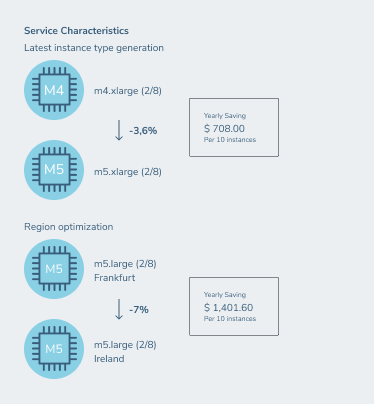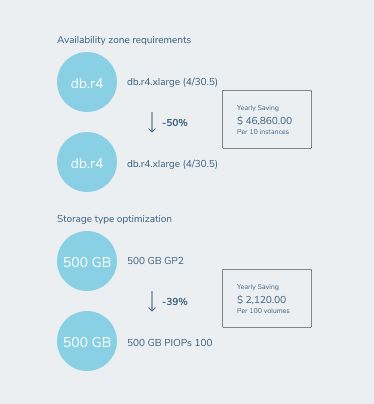In our first blog we introduced you to Cloud Financial Management and the continuous Cloud Financial Management framework. We talked about Service Rightsizing and what rightsizing is all about. In the second blog in this series, we talked about the Purchase Model Optimization. Let’s move on to Perspective 3: Service Characteristics. Are you using the AWS service according to the latest cost-effective best practices? AWS releases new generations of instances every year, each more price efficient than the last. For that case, we advise you to regularly review whether you would benefit from upgrading to these new instance generations when they become available.
AWS Service Characteristics Optimization
As you’re used to by now, we will demonstrate this with actual prices and services. A migration from a M4 series instance (older gen) to a M5 series (next gen) would save almost 4% on the spend of that particular resource. Aside from this, the region that you choose to run your cloud workload can also influence your cloud bill. When comparing the same provisioned workload in Frankfurt to Ireland as an alternative, you would also save up to 7-10% on the resource cost for the same performance. This can be explained by the difference of local costs in different regions (labour, electricity, housing). We advise you to extensively research which region is best suited for your operations and optimize accordingly.

Availability Zone Requirements
Again, we have summed up a few other practical applications that you can implement today. The first one is Availability Zone Requirements. If you use AWS RDS databases, you can deploy them as “highly available” in a multiple availability zone setup. This feature creates a backup database and thus directly doubles the costs. For critical production workloads this is a common practice. But, maybe for Dev/Test/Acceptance workloads and even some other production workloads it is not a strict requirement. You can reduce a serious amount of cost by provisioning those workloads in a single availability zone, if this suits your organizational requirements.
Storage Type Optimization and caching
If you go from provisioned IOPS to a more general purpose SSD in the EBS service of Amazon, you would also be able to save up to 70% in this calculation. Additionally, make use of scalability and ensure that your indexing on the DynamoDB table is optimized.

More to consider
These examples point out how we look from this perspective but there are many more examples. If you’re running massively in AWS at least dive into the following to consider as well:
- Latest instance type family
- Storage types/storage tier
- Multi AZ deployment Evaluation
- RDS Storage autoscaling
- Region optimization
- DynamoDBIndex optimization
- Scalability
- TTL and Cache optimization
How to optimize your AWS costs even further
Do you have any further questions around AWS Service Characteristics optimization? Feel free to contact us. Ready to learn more about the five perspectives? Read up on Perspective 4: Service Architecture Optimization in the next blog. Need this knowledge on the go, or do you want to share it with a colleagues? Download the full original whitepaper here: ‘AWS Cost Optimization in Five Perspectives’.




